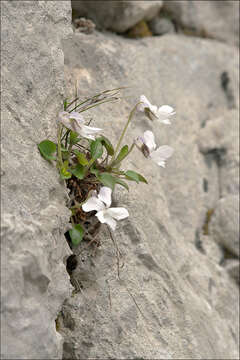Viola-rupestris-fo-alba_26

Description:
Viola rupestris (fo. alba) Schmidt, syn.: Viola arenaria DCTeesdale Violet (white form), DE: Felsen-Veilchen (weie Form), Sand-VeilchenSlo.: skalna vijolica beli razliekDat.: April 7. and 8. 2016Lat.: 46.35758 Long.: 13.70077Code: Bot_941/2016_DSC0906, Bot_942/2016_DSC1107Habitat: In crevices of stony wall of a road side and above it in sparsely overgrown sandy scree, calcareous rock, fairly sunny, dry and open place; south aspect; elevation 535 m (1.755 feet); average precipitations ~ 3.000 mm/year, average temperature 6-8 deg C, alpine phytogeographical region. Substratum: soil in stony wall crevices and among sandy scree.Place: Lower Trenta valley, between villages Soa and Trenta, right bank of river Soa, main road Bovec-Vri; near Matev farm house, Trenta 1, East Julian Alps, Posoje, Slovenia EC Comment: Viola rupestris is considered a rather scattered to rare violet although it is widely distributed in European mountains and west Asia. It is usually growing on dry to semidry, grassy places. It is a small plant (lower than 10 cm) with leaves smaller than 2 cm and blue-violet flowers. But sometimes one can find also white flowering plants and such, which grow on rocks or rocky walls. In Trenta valley white and blue-violet plants growing in grassland and on stony walls can be found.In Slovenia almost thirty species of violets are known. Distinguishing among them is not always simple. Many traits (including color of flowers, shape of leaves, hairiness and odor) are variable and hybrids are frequent. In addition juvenile plants differ significantly from mature (summer) ones (particularly in leaves and hairiness). Viola rupestris belongs to a group of violets, which have true stalk with nodes and stalk leaves and two or more ground leaves in a rosette. Calyx leaves are pointed. Characteristic traits are also: flower stalks are covered with very short (0.1 mm!) and dense (unfortunately, not always) hairs; ovary is also hairy and two very, very small, opposite flower-stalk leaves are positioned above one half of the length of the flower-stalk, sometimes just below the flowers themselves.Ref.:(1) Personal communication with Dr. Igor Dakskobler, Natural History Institute 'Jovan Hadi', SAZU.(2) M.A. Fischer, W. Adler, K. Oswald, Exkursionsflora fr sterreich, Liechtenstein und Sdtirol, LO Landesmuseen, Linz, Austria (2005), p 432.(3) A. Martini et all., Mala Flora Slovenije (Flora of Slovenia - Key) (in Slovenian), Tehnina Zaloba Slovenije (2007), p 417. (4) D. Aeschimann, K. Lauber, D.M. Moser, J.P. Theurillat, Flora Alpina, Vol. 1., Haupt (2004), p 436.(5) K. Lauber and G. Wagner, Flora Helvetica, 5. Auflage, Haupt (2012), p 400.(6) H. Haeupler, T. Muer, Bildatlas der Farn- und Bluetenpflazen Deutschlands, Ulmer
Included On The Following Pages:
- Life (creatures)
- Cellular (cellular organisms)
- Eukaryota (eukaryotes)
- Archaeplastida (plants)
- Chloroplastida (green plants)
- Streptophyta
- Embryophytes
- Tracheophyta (ferns)
- Spermatophytes (seed plants)
- Angiosperms (Dicotyledons)
- Eudicots
- Superrosids
- Rosids
- Malpighiales
- Violaceae (viola family)
- Viola (violet)
- Viola rupestris (teesdale violet)
This image is not featured in any collections.
Source Information
- license
- cc-by-nc-sa
- copyright
- Amadej Trnkoczy
- photographer
- Amadej Trnkoczy
- original
- original media file
- visit source
- partner site
- Flickr Group
- ID


